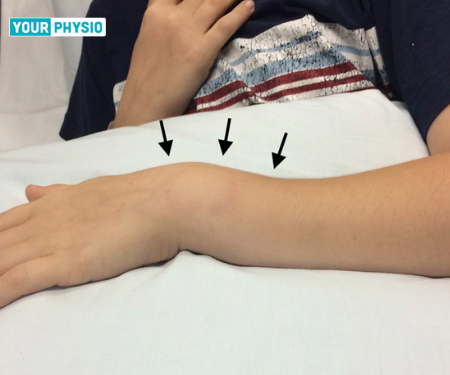Introduction
The wrist joint is made up of the Ulna, radius, and carpal bones. A Colles fracture includes the distal 2 cm of the radius bone dorsally.
A distal colles fracture quite often happens around 1 inch from the end of the radius bone. A colles fracture is also known as a broken wrist fracture. It is the most widely recognized wrist fracture.
This fracture can happen in various ways to individuals.
In youngsters, such fractures are caused due to a high-energy impact on the bone. Mostly due to a fall in the wrist, or while playing any sport.
In elderly individuals, osteoporosis or arthritis can increase the chances of a colles fracture.
Osteoporosis is when with age the bones start losing their shape and calcium content making the bone porous, like a sponge. Whereas, arthritis is a condition in which the fluid between bones reduces causing friction. Both these conditions can cause a fracture in elderly individuals.
Types of colles fractures:
1. Intra-articular fracture - articular means joint. This type of fracture affects the wrist joint entirely.
2. Extra-articular fracture- A fracture that doesn't reach out into the joint is called an extra-articular fracture.
3. Open fracture- When a broken bone fractures the skin, it is called an open fracture.
4. Comminuted fracture- When a bone is broken into multiple pieces, it is known as a comminuted fracture.
Open and comminuted fractures are harder to treat. They require surgical correction of the bone using plates and screws.
Symptoms of colles fracture
A broken or fractured wrist can cause pain, swelling, and inflammation. The hand is even seen in a fork-like appearance.
The nerve(s) to the hand can also be impacted by the injury. Causing numbness in the fingers.
Any movement of the wrist could be extremely painful.
Treatment of colles fracture
There are numerous treatment choices for a distal radius fracture. The decision relies upon many aspects. For example, the location of the fracture, age, and movement level, and the specialist's best judgement.
1. Nonsurgical Treatment
Assuming a fracture is not complicated. A cast might be applied until the bone heals. In uncomplicated fractures, the cast is regularly taken out around a month and a half after the fracture occurred.
Physiotherapy is required to improve the movement and range of the injured wrist. Normally, a removable brace is used between physiotherapy sessions. This is done to protect the healing bone.
2. Surgical Treatment
With complicated fractures like an open fracture, or comminuted fracture. It is important to re-adjust the injured and broken bone sections.
Surgery is done to realign the fractured bone pieces. A supporting cast might be put on your arm to prevent the bones from moving. A cast is usually applied for two to three weeks. This is typically done to reduce swelling and avoid movement.
The kinds of aids used in surgery are:
Metal pins (normally hardened steel or titanium). Commonly used in children
Plate and screws
External fixator
A combination of these methods
For Open fractures. A surgical procedure is performed immediately. To prevent any further complications like infection or excessive blood loss.
Colles fracture Complications:
A malunited colles fracture is very common. This happens when the bone segments have not healed. Or there is no new bone formation in the injured segment.
A mal-united fracture can occur after surgical as well as non-surgical treatment.
1. Wrist stiffness is the most common complication.
2. Compartment syndrome. An excessive amount of tension in the area causes pain.
3. Medial nerve paralysis.
4. Carpal tunnel syndrome incorporates torment, deadness, and shortcoming in your wrist and hand.
Pain Management
Most fractures hurt from a couple of days to two or three weeks. Numerous patients observe that using ice, holding their arm up, and pain relief drugs help with the pain.
Raising your arm above heart level
Applying ice. Like a towel wrapped in a cold pack.
Pain relief drugs can also help in reducing pain.
Cast and Wound Care
Casts are usually removed within two to three weeks. Reduced swelling inside the cast indicates healing of the fracture. For complicated fractures, the cast is usually kept for a month or more.
The cast should be kept dry at all times. A plastic bag over the arm while bathing should help. If the cast does get wet. Using a hairdryer to dry off the cast is necessary.
Physiotherapy Management
1. Post-surgical management of colles fracture is done through physiotherapy. Pain, swelling, decreased movement, and numbness is treated. The patient complains of inability in performing daily tasks.
2. In the first 7-8 weeks post-fracture. The therapist aims at reducing pain. A combination of modalities is used.
3. The therapist uses heat or wax therapy to decrease pain. Heat therapy even helps in increasing the range of movement of the wrist.
4. Deep-tissue massage techniques. For reducing swelling and improving movement. The scar area is massaged by the therapist.
5. Cold therapy. Cold therapy may be used to reduce the swelling. Most commonly used in the first 2-3 weeks after injury.
6. TENS (Transcutaneous electrical nerve stimulation) may be used to reduce pain. It is even very useful in increasing the level of movement with the wrist.
7. Exercises to improve movement are started after 4-5 weeks of surgery. The muscles around the wrist are strengthened to increase movement.
8. Mobilisation of the joints is also performed. This helps in the early healing and recovery of the fracture.
9. Finger hand exercises are trained. This helps in maintaining the movement of fingers. Different shaped objects are used by therapists for this purpose.

Illustrations designed by freepik